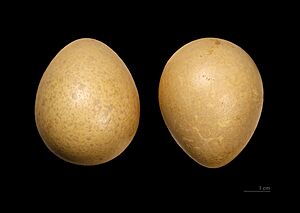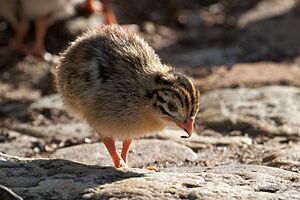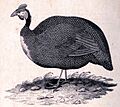Helmeted guineafowl facts for kids
Quick facts for kids Helmeted guineafowl |
|
|---|---|
 |
|
| Specimen in Serengeti National Park, Tanzania | |
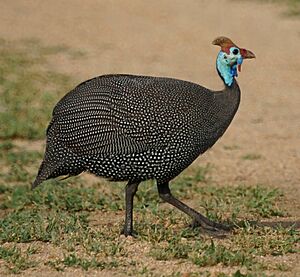 |
|
| Specimen in the Kruger National Park, South Africa | |
| Conservation status | |
| Scientific classification | |
| Genus: |
Numida
|
| Species: |
meleagris
|
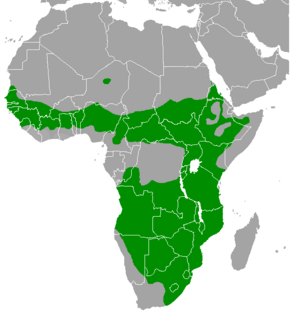 |
|
| Natural range. Introduced to Western Cape, Madagascar and elsewhere. | |
| Synonyms | |
|
|
The helmeted guineafowl (Numida meleagris) is a very well-known bird from the guineafowl family. It is the only type of bird in its group, called Numida. These birds originally come from Africa, mostly south of the Sahara desert. But people have taken them to many other places, like the West Indies, North America, Australia, and Europe, where they are often kept as farm birds.
Contents
About the Helmeted Guineafowl
The helmeted guineafowl is a large bird, usually about 53 to 58 centimeters (21 to 23 inches) long. They weigh around 1.3 kilograms (2.9 pounds). Their bodies are gray-black with many small white spots, like sprinkles.
What Does It Look Like?
Like other guineafowl, this bird has a head with no feathers. Instead, it has a dull yellow or reddish bony knob on top. Its bare skin can be red, blue, or black. Their wings are short and round, and their tail is also short. There are different types, or subspecies, of helmeted guineafowl. They mostly look different in the shape, size, and color of their head knob and the skin flaps on their face.
Where Do They Live?
Helmeted guineafowl prefer warm, dry, and open places. You can find them in areas with scattered shrubs and trees, like savannas or farmlands.
How They Behave and Live
These birds like to live in groups. Outside of breeding season, they often form flocks of about 25 birds. They also sleep together in these groups. Guineafowl are very good at eating lots of ticks, which helps stop the spread of diseases like Lyme disease.
On the Ground and in the Air
Helmeted guineafowl spend most of their time on the ground. When they are scared, they usually run instead of flying. They can run very fast and are good at moving over bumpy ground. They can walk 10 kilometers (6 miles) or more in a single day! When they do fly, it's usually a short, fast burst, and then they glide to cover longer distances. If they are disturbed, they make loud, harsh calls.
What Do They Eat?
Their diet includes both plants and small animals. When they are not breeding, they eat things like corn, roots, and seeds, especially from plants that grow in farms. They also eat leftover crops. During breeding season, more than 80% of their food can be small creatures like insects, especially beetles. Guineafowl have strong claws and scratch the loose soil to find food, much like chickens do. They usually don't pull up growing plants. They can live for up to 12 years in the wild.
Fighting and Nesting
Male guineafowl often fight each other. They try to look scary by raising their wings and puffing up their feathers. They might also rush at their opponent with their beak open. The nest is usually a hidden spot on the ground, often just a shallow dip. A female usually lays 6 to 12 eggs. She sits on them for 26 to 28 days until they hatch. If you see a nest with many more eggs, it's probably because more than one female used the same nest.
Reproduction and Young Birds
Helmeted guineafowl breed during certain times of the year. Summer is usually their main breeding season. The young birds are called keets. Their feathers grow quickly, allowing them to flutter onto low branches just about a week after they hatch.
Domestication

The helmeted guineafowl is often kept by people. This is the type of guineafowl that you might see sold in stores. Wild groups of these birds, which came from domesticated ones, now live in many places around the world, including the West Indies, North America, Australia, and Europe.
Images for kids



